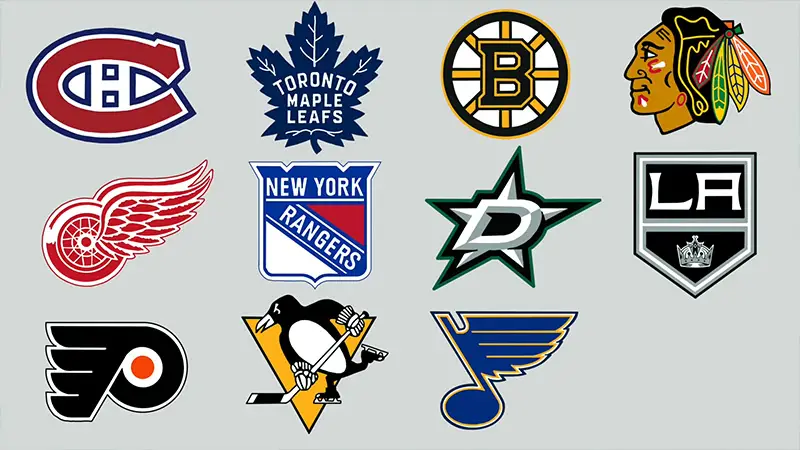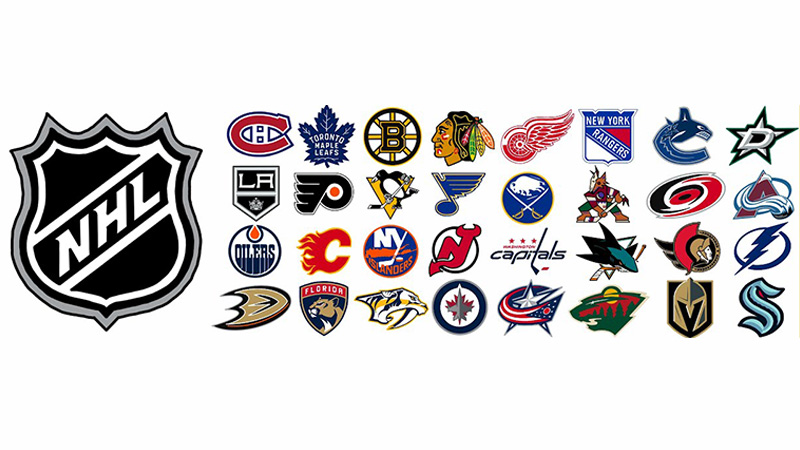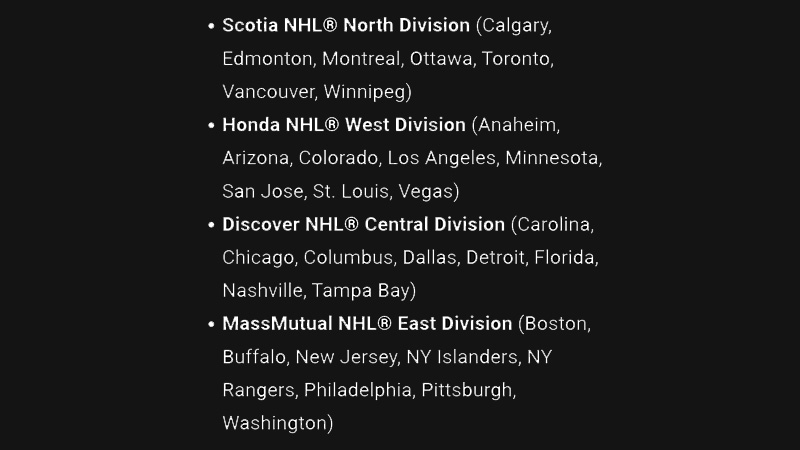In the world of professional sports, the National Hockey League (NHL) has a unique tradition that often raises eyebrows among fans and enthusiasts—the peculiar naming of its divisions.
Over the years, the NHL has been a subject of both admiration and criticism for its division names, which some consider uninspiring, outdated, or simply confusing.
This blog post delves into the intriguing topic of why the NHL division names have often been labeled as “terrible.”
From the Original Six era to the recent forays into sponsor-based division naming, the NHL’s journey through division nomenclature has been a rollercoaster ride.
We’ll explore the historical context, factors contributing to division name changes, and the impact on the fan experience.

Historical Division Names of NHL
The National Hockey League (NHL) has undergone several division realignments and name changes over the years. Here are the historical division names in the NHL:
Original Six Era (1942-1967)
There were no divisions during this period, as the NHL consisted of just six teams.
They are the Montreal Canadiens, Toronto Maple Leafs, Boston Bruins, Chicago Black Hawks (now Blackhawks), Detroit Red Wings, and New York Rangers.
Expansion Era (1967-1974)
In 1967, the NHL expanded from six to twelve teams and introduced the Eastern and Western Divisions.
- Eastern Division: Consisted primarily of the Original Six teams.
- Western Division: Included the new expansion teams.
1974-1981
In 1974, the NHL realigned into two new divisions.
- Adams Division: Named after former NHL president Clarence S. Campbell, this division featured teams from the Eastern United States and Canada.
- Norris Division: Named after James E. Norris, this division featured teams from the Western United States and Canada.
1981-1993
The NHL realigned again in 1981 into the Patrick, Adams, Norris, and Smythe Divisions.
- Patrick Division: Named after Lester Patrick, featured teams primarily from the Eastern United States.
- Adams Division: Continued to include teams from the Eastern United States and Canada.
- Norris Division: Continued to feature teams from the Western United States and Canada.
- Smythe Division: Named after Conn Smythe, featured teams from the Western United States and Canada.
1993-1998
The NHL underwent further realignment in 1993, leading to the introduction of the Eastern and Western Conferences.
- Eastern Conference: Included the Northeast, Atlantic, and Southeast Divisions.
- Western Conference: Included the Central and Pacific Divisions.
1998-2013
The NHL realigned yet again in 1998.
- Eastern Conference: Included the Atlantic, Northeast, and Southeast Divisions.
- Western Conference: Included the Central and Pacific Divisions.
2013-2021
In 2013, the NHL underwent another significant realignment.
- Eastern Conference: Included the Atlantic and Metropolitan Divisions.
- Western Conference: Included the Central and Pacific Divisions.
The NHL has been known to adjust its divisions and playoff formats to accommodate expansion and other league changes.
You can check the latest NHL standings and division names for the most up-to-date information.
Why Are The NHL Division Names So Terrible?
The perception of whether NHL division names are “terrible” or not is subjective and can vary from person to person.
However, there are several reasons why some fans and observers have criticized NHL division names over the years:
Lack of Creativity
Some people feel that the division names lack creativity or meaningful connection to the sport or its history.
Many divisions are named after former NHL officials or executives, which might not resonate with fans.
Frequent Changes
The NHL has undergone multiple division realignments and name changes over the years. This can lead to confusion among fans who have to adapt to new division names and structures frequently.
Regional Confusion
Some division names, especially in earlier eras, did not clearly represent the geographic locations of the teams within them. This could be confusing for fans, especially those who were new to the sport.
Nostalgia for Original Six Era
Some fans have a deep nostalgia for the Original Six era when the NHL didn’t have divisions, and teams played a balanced schedule against each other.
They may prefer this simpler approach to the current division-based structure.
Preference for Team Names
Some fans might prefer division names that reference the teams themselves or elements of the game, as opposed to naming them after individuals or historical figures.
It’s important to note that the NHL has made efforts to address some of these concerns in recent realignments.
For example, the division names introduced in 2013 (e.g., Atlantic, Metropolitan, Central, Pacific) were designed to be more geographically descriptive and easier for fans to understand.
Additionally, the league often considers factors like travel logistics and competitive balance when making these changes.
Ultimately, the perception of division names is a matter of personal preference, and opinions on this topic can vary widely among NHL fans.
Some fans might appreciate the historical context of the names, while others may prefer more modern or descriptive division names.
Recent Changes and Confusion Regarding NHL Division

The NHL has historically made changes to its divisional alignment for various reasons, including expansion, relocation of teams, and efforts to create more balanced competition.
These changes can sometimes lead to confusion among fans as they adjust to new division names and structures.
To address this, the NHL has typically communicated these changes to fans through official announcements, updated schedules, and other means.
Some factors that can lead to changes and potential confusion in NHL divisions include:
Expansion and Relocation
When the NHL adds new teams or relocates existing ones, it often necessitates the realignment of divisions to accommodate the new franchises or address geographical considerations.
Temporary Changes
In response to unique circumstances, such as the COVID-19 pandemic, the NHL has implemented temporary divisional realignments to reduce travel and mitigate health risks. These changes may lead to adjustments in playoff formats and scheduling.
Name Changes
The NHL occasionally rebrands divisions with new names, as seen in the 2013 realignment when the league introduced divisions with names like Atlantic, Metropolitan, Central, and Pacific to make them more geographically descriptive.
Competitive Balance
The NHL may adjust divisions to create more balanced competition, aiming to ensure that teams have equitable schedules and opportunities to make the playoffs.
If you’re looking for information on recent changes or divisional confusion in the NHL, it’s better to visit the official NHL website or check the latest news and updates from reputable sports news sources.
The NHL regularly communicates changes in divisional alignment and playoff formats to fans and the media to minimize confusion.
Examples of the Uninspiring Names Used in the NHL Division

The NHL introduced temporary division names for the 2020-2021 season due to the unique circumstances of the COVID-19 pandemic.
These names were criticized by some fans for being sponsored and less traditional compared to the historical division names.
Here are examples of some of those temporary division names:
MassMutual East Division
This division was named after its sponsor, MassMutual, an insurance company.
The teams in this division included the Boston Bruins, Buffalo Sabres, New Jersey Devils, New York Islanders, New York Rangers, Philadelphia Flyers, Pittsburgh Penguins, and Washington Capitals.
Honda West Division
Similarly, the Honda West Division was named after its sponsor, Honda, an automotive manufacturer.
The teams in this division included the Anaheim Ducks, Arizona Coyotes, Colorado Avalanche, Los Angeles Kings, Minnesota Wild, San Jose Sharks, St. Louis Blues, and Vegas Golden Knights.
Scotia North Division
The Scotia North Division was named after its sponsor, Scotiabank, a Canadian banking institution.
This division featured all seven Canadian NHL teams due to border restrictions during the pandemic: Calgary Flames, Edmonton Oilers, Montreal Canadiens, Ottawa Senators, Toronto Maple Leafs, Vancouver Canucks, and Winnipeg Jets.
Discover Central Division
The Discover Central Division was sponsored by Discover Financial Services.
The teams in this division included the Carolina Hurricanes, Chicago Blackhawks, Columbus Blue Jackets, Dallas Stars, Detroit Red Wings, Florida Panthers, Nashville Predators, and Tampa Bay Lightning.
These division names were temporary and were implemented to help generate revenue for the league during a challenging season impacted by the pandemic. They were not intended to be permanent.
The NHL has historically used more traditional and geographic division names, as well as names based on historical figures or team-related themes.
However, the league occasionally incorporates sponsor names for promotional and financial purposes.
Role of Sponsorships in Division Naming
Sponsorships in division naming play a significant role in generating revenue for professional sports leagues like the NHL. Here’s an overview of the role of sponsorships in division naming:
Revenue Generation
One of the primary reasons for incorporating sponsor names into division titles is to generate additional revenue for the league.
Companies pay a substantial amount for the naming rights, and this income can be used to support various aspects of the league, including player salaries, marketing efforts, and infrastructure improvements.
Promotion and Brand Exposure
Division naming sponsorships provide companies with a valuable platform to promote their brand to a wide audience of sports fans.
The company’s name becomes closely associated with the division and is featured prominently in various marketing materials, broadcasts, and media coverage.
Enhanced Fan Engagement
Sponsorships can enhance fan engagement by creating additional storylines and points of interest.
Fans may become more interested in division rivalries or matchups due to the presence of a well-known sponsor associated with the division.
League and Team Sustainability
The revenue generated from sponsorships can contribute to the financial sustainability of both the league and individual teams.
This funding can help teams remain competitive by providing resources for player acquisitions and development.
Supporting Events and Initiatives
Sponsorship revenue can also be used to support special events, community initiatives, and youth development programs organized by the league or individual teams.
This can have a positive impact on the sport’s growth at various levels.
Cultural and Geographic Relevance
Some sponsorships aim to align the league or division with a brand that has cultural or geographic relevance to the sport.
For example, a financial institution sponsoring a division in a league with a strong financial base or a regional company sponsoring a division with teams from a specific geographic area.
Contract Duration
Sponsorship agreements can vary in duration.
Some may be short-term agreements lasting a few years, while others can be long-term partnerships that extend for a decade or more, providing the sponsor with a sustained presence in the league.
It’s worth noting that the inclusion of sponsor names in division titles can be a subject of debate among fans and traditionalists, as it represents a shift away from the more traditional and geographic division naming conventions.
However, from a business perspective, sponsorships are a valuable source of revenue that helps support the growth and stability of professional sports leagues.
FAQs
Why do NHL division names often receive criticism?
NHL division names are criticized for their lack of creativity and connection to the sport.
Many are named after individuals or historical figures, which some fans find uninspiring compared to more descriptive or team-related names.
Are division name changes common in the NHL?
Yes, the NHL has undergone multiple division realignments and name changes over the years due to factors like expansion, relocation, and competitive balance.
How do NHL division names impact the fan experience?
Division names can affect fan engagement. Some fans prefer names that resonate with the sport’s history or geography, while others may find sponsor-based names less appealing.
What was the motivation behind recent sponsor-based division names?
Recent sponsor-based division names were introduced for revenue generation during the COVID-19 pandemic.
They provided companies with a platform for brand exposure while supporting the league financially.
Do all fans dislike NHL division names?
No, opinions on division names vary. Some fans appreciate the historical context, while others prefer more modern or descriptive names.
It’s a matter of personal preference, and not all fans consider them “terrible.”
Wrapping Up
While opinions on the NHL division names may vary, one thing is clear: they have played a pivotal role in the league’s history and identity.
From the simplicity of the Original Six era to the recent experiments with sponsorships, these names have evolved to reflect the league’s changing landscape.
Some may find them uninspiring, while others appreciate the historical context they bring to the game. As the NHL continues to adapt and grow, it’s likely that division names will remain a topic of discussion among fans.
Whether you love them or loathe them, there’s no denying that NHL division names, with all their quirks and controversies, are an integral part of the league’s rich tapestry.
As the sport continues to evolve, so too may the names that define its competitive landscape. Thank you for your time.




Benjamin Kenyon